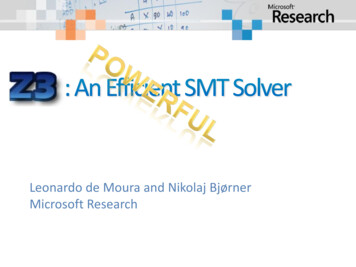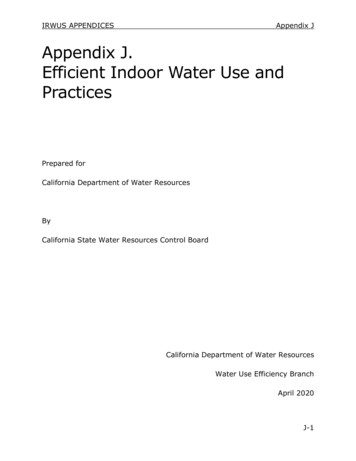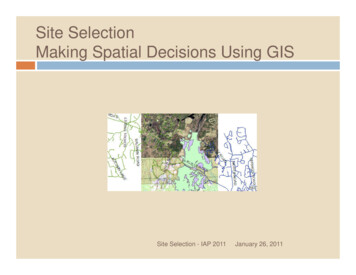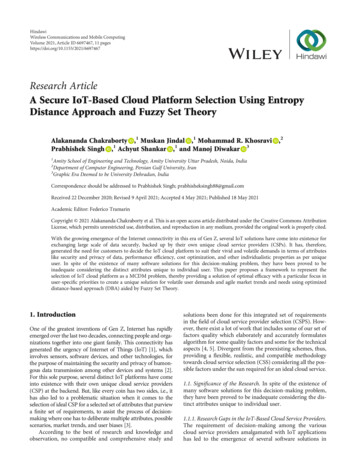
Transcription
2014 IJEDR Volume 2, Issue 2 ISSN: 2321-9939An Efficient Web Service Selection using Hadoopecosystem based Web Service Management System(HWSMS)1Shashank, 2Shalini P.R, 3Aditya Kumar Sinha1PG Scholar, 2Assistant Professor, 3Principal Technical Officer1Computer Science and Engineering,1NMAM Institute of Technology, Nitte, Karnataka, India1Centre for Development of Advanced Computing (CDAC),, Pune, India1Shashankshetty06@gmail.com, 2Shalini.pr.2007@gmail.com, 3Saditya@cdac.inAbstract— A Hadoop ecosystem based Web Service Management System (HWSMS) mainly focuses on selecting the optimal webservice using the two algorithms Optimal Web Service Selection (OWSS) and Advanced Stop Words Based Query Search (ASWQS).The distributed management framework is the key research issue that still needs to be addressed in service managementresearch field. As the part of this effort, this paper focuses on the study on web services and discusses on the Hadoop WebService Management System (HWSMS) which manages web services using the big data problem resolver tool, HadoopEcosystem. Due to the growing popularity of Service Oriented Architecture (SOA) and the web technology, there has beenan huge impact on the web service repository. The data on the network has been increasing in the daily basis, hencemaking it huge and complex. This causes a gradual decrease in the performance and does not fulfill the user requirementand also QoS metric. Hence, In the proposed method, web service management using Hadoop ecosystem has beendiscussed. The user query is processed using the Map Reduce Optimal Web Service Search (OWSS) algorithm and theoptimal web service out of several web services is delivered to the service requestor by filtering the unnecessary webservices. Hence, an efficient web service selection process can be carried out and better QoS to the customer. Theexperimental setup of HWSMS is implemented and the results are analyzed with the traditional SystemIndex Terms— SOA ; Web service; Hadoop; MapReduce; Big data; Web service management; Web service CompositionI. INTRODUCTIONToday, the amount of information that is currently available in internet is XML format which is growing is in a fast pace. Hencewe can consider the web as the biggest knowledge base, which is made available to the public. Due to the convergence of manynew technologies such as Service Oriented Architecture (SOA), high speed internet and web service [15] has given rise to a newkind of software developers: Web service providers These web service providers develop their application in such a way that it canfunction as technology independent and also they are reusable. These web services are accessible through service orientedarchitecture via internet.The success of these web service providers mostly depend on the Quality of services (QoS) that they offer their customers andalso meeting all the customer requirements. Hence, there is requirement of adequate service management, which is essential fortheir business. It also helps in fulfilling the current and future requirements of the customers and also to improve the QoS. Some ofthe issues that occur during the management of the web service are network failure, web service security and web serviceavailability.The paper mainly focuses on the two main issues and we treat these issues as a big data problem. One is the storage efficiency,that is when there is huge amount of requests from the customer, and then the web service repository must be efficiently searched.Hence this huge amount of data comes under big data problem. That is dataset which continuously grows and cannot be processedusing the traditional relational database [5]. Henceforth, this web services cannot be managed using a traditional databasesefficiently. That is traditional UDDI [2] service repository model cannot be used when the web services is large. Secondly, whenthere is a complex web services, then efficient selection of web services is a difficult task. Hadoop [6][9] is one of the tool used totackle against big data problem [8]. Hence novel approach of managing web services using Hadoop is developed [7].This approach overcomes the complexities which arise in traditional web service management methods. This paper discusesabout the novel Hadoop based approach of managing a web service. Some of the Hadoop ecosystems like Hadoop Distributed filesystem (HDFS) [6], MapReduce [6] and Hadoop database (HBASE)[6] is combined together to manage the web services and alsoselecting a best optimal web service from the several web services. HDFS provides a reliable distributed storage of the web service,Map-Reduce retrieves optimum services by filtering the unwanted services and HBASE is used to store the functional and nonfunctional property.II. RECENT WORKSIn simple terms, the web service is the piece of the software application whose features are defined by the XML based language[42]. Some of the examples of the web service are online ticket purchase, online hotel reservation and auction. As a buildingIJEDR1402096International Journal of Engineering Development and Research (www.ijedr.org)1876
2014 IJEDR Volume 2, Issue 2 ISSN: 2321-9939block of web service many protocols and technologies were developed. Some of the few technologies are as follows: UniversalDescription, Discovery, and Integration (UDDI) [1] [2], Simple Object Access Protocol (SOAP) [3] and Web Service DescriptionLanguage (WSDL) [4]. UDDI provides a service registry for web service discovery and advertisement. SOAP acts as anfoundation framework for communication of the web services. WSDL provides the service provider an platform to describe theirapplications. DAML-S [37] is DAML based web service ontology which defines a standard for web service discovery andmessage passing. It provides the standard set of mark-up language for the web service providers to describe the properties of theirweb services in computer interoperable form. Some of the other initiatives towards web service are Business Process Executionlanguage for web service (BPEL4WS) [46] which is considered as the standard for web service composition. This BPEL4WSallows to create different complex processes and wire them together, for example invoking web services, data manipulation,throw errors or end the process. Both DAML-S and BPEL4WS focuses on the representation of web service composition, whereprocess and also binding of it is known priori.Web service discovery involves locating or finding the exact individual web services from the service registry and retrievingpreviously published description for new web application. For example UDDI registry [2] where it contains white pages for allcontact information, yellow pages for industry taxonomies and green pages for technical information about web services. UDDIenquiry is an API provided by the UDDI to interact with the system, that is it locates and finds UDDI registry entry. Simplesearch engines like [18] [19] [20] are used to find the required web services. As of now these search engines provide a simplekeyword based search on web service description and the most of the UDDI search engines are limited to syntax based search.The client can just search the UDDI registry based on the string in the service description.Bellur et al. [40] discusses about the improved matchmaking algorithm for dynamic discovery of the web service. The methodinvolves selecting a web services by constructing the bipartite graph and defining the optimal web services from it. The largenumber of possible paths in a larger data paths need to be searched in a given time period. Hence this high space complexitymakes above traditional methodology weaker when searching the large web service repositories. Dong et al [21] discusses a newmethod of search engine using similarity search mechanism. The query is transformed into a common representation and then fora particular query related web service is found. This method may have a problem while searching a large collection within acertain time limit. N. Gholamzadeh et al. [17] proposes data mining based web service discovery technique. Here fuzzy clusteringbased algorithm for discovering similar web service using a single query is developed. Y. Zhang et al. [22] defines a web searchengine approach for finding the desired services using functional and non functional QoS characteristics. Sreenath et al. [23]discusses that web service discovery is an exhaustive process, because lot of services are found. Selecting best among them is acomplex task. Hence the agent based approach is formulated for web selection.Web service composition also plays a vital role in web service research. Web service composition is technique to combinesimple web service to satisfy the user requirement. Kona et al [45] discusses about the semantic web service composition whereacyclic graph from the input request is generated iteratively. Hence, all possible services that are invoked are added to the graph.Therefore, causing difficulty in eliminating the unwanted web service. Mier et al. [43] discusses about the automatic web servicecomposition using A* algorithm. Firstly, web service dependency graph is computed using the method discussed in Kona et al's[45] work. Later, the unwanted web services are eliminated and finally A* search algorithm is applied to find the optimal webservice.Q. Yu et al. [39] discusses various research issues and solutions for deploying and managing web services. U. Srivastava et al.[14] in his work reviews about the web service management system [13] which allows multiple querying simultaneously in anintegrated manner. M. Ouzzani et al. [16] introduced efficiently querying with web service. Proposed query model consist of threelevels, query level which acts as a user interface for giving queries, virtual level for web service operations, and finally concretelevel consist of all the related web services. Zheng et al. [41] provides a experimental evaluation on the real world dataset of webservices when accessed across the country.When the query request becomes huge then the response time will gradually decrease. So, In the proposed method we integrateweb service management with Hadoop ecosystems to gain more accurate results. So key difference between the Hadoop model andall the above model is that we intend to build the web service management system with QoS metrics like reliability, higherthroughput, higher response time and availability. With the QoS metrics, the proposed model works on larger web request and inresponse produces optimal web services by filtering unwanted web services.III. COMPARATIVE ANALYSIS OF WEB SERVICE MANAGEMENT METHODSThe comparative analysis between the traditional web service management methods with the proposed methods has beendiscussed in the Table 1. The comparative analysis briefly explains the advantages of the proposed methods upon traditionalmanagement methods.Table 1 Difference between the traditional and the proposed methodWeb Service ManagementMethodsTraditional UDDI [2] andSOAP [3] based vantagesMost of the traditional webservices managementmethods [18] [19] [20] [23][40] relies on the UDDI andSOAP based architecture.1) Efficient management ofweb service and increase inresponse time when it comesto small task or fetching webservice from smaller data1) These traditional distributedarchitecture provides a loosecoupling between variouscomponents and are sensitive.2) As the rate in the businessInternational Journal of Engineering Development and Research (www.ijedr.org)1877
2014 IJEDR Volume 2, Issue 2 ISSN: 2321-9939Proposed Hadoop based webservice managementarchitectureThe SOAP which is aframework that gives thefoundation for messaging andupon which various webservices are built.repository.The proposed Hadoop basedarchitecture is integration ofthe big data problem resolvertool Hadoop ecosystems withthe web service. Theproposed MapReducealgorithm is used to providethe optimal web services bysearching the huge amount ofweb services from the HDFS.1) Since the Hadoop workson large amount of data, thelarge repository can beefficiently searched toprovide the optimal webservices by filtering theunwanted web services.2) Higher QoS whencompared to the traditionalarchitecture when processingterabytes of datachange increase and largenumbers of user delegate theirtask into the system, theproblem arises. Those are websites unavailable orunresponsive,1) When the web services aresmall, the traditionalarchitectures can be usedinstead of Hadoop. Butnowadays we don't find suchsmall repositories.IV. PROBLEM STATEMENT AND IMPLEMENTATIONThe core framework of the Hadoop based web service management is similar to the reference [7]. Due to the overwhelmingpopularity of a web service, there has been a huge amount of web request and can be treated it has a big data. Hence the webservice architecture is integrated with the Hadoop ecosystems like MapReduce, HDFS and HBASE to manage it more efficiently toobtain the necessary QoS metrics.The managing web service using Hadoop ecosystem framework has four major components (fig 1):A. Infrastructural Setup of HadoopThe Hadoop is framework which is used to process and store a huge amount of data. This framework is integrated with the webservice to manage it efficiently to gain higher QoS. Hence the infrastructural setup of Hadoop ecosystem is built using thefollowing steps:IJEDR1402096International Journal of Engineering Development and Research (www.ijedr.org)1878
2014 IJEDR Volume 2, Issue 2 ISSN: 2321-9939Fig 1: Hadoop ecosystem to manage and select web services1.2.3.4.Downloading and installing Java 1.6 from http:// www.oracle.com [48], Eclipse Europa 3.3.2 from http://www.eclipse.org [49] and Cygwin from http://www.cygwin.com [50] by configuring and starting SSH Daemon.Download Hadoop from http://archive.apache.org/ [51], copy it in Cygwin home folder, and unpack HadoopConfigure Hadoop by editing the configuration file hdfs-site.xml, mapred-site.xml and core-site.xml . Also installHadoop eclipse plug-in [52] and change the eclipse java perspective to MapReduce environment.Download and install Zookeeper [53] and HBASE [54] from http://archive.apache.org/, Setup Hadoop location in eclipseand start all the cluster. Now, Hadoop ecosystem is setup for any task.B. Service ProviderThe Service provider is integrated with HDFS to provide a service to a Requestor entity. HDFS [6] [35] is used for distributedstorage of data to solve the problem of storing big data. HDFS mainly represented by Name node and by Datanode which aremaster and slave node respectively. HDFS consist of one Namenode, one secondary node and many Datanodes. The Namenode isused to store metadata of a file system, providing user access permission to the user. Secondary Namenode acts has a backup tothe master Namenode. All the data are stored in the Datanode, and replication of data is also done to three different nodes toachieve copy storage policy. Periodically, data node has to be in contact with the master node. when user wants to read fromHDFS then request is sent to the Namenode. Namenode gets the node, file block information from the metadata table by queryingit. These information is sent back to user and user can directly have an access to the Datanodes. When user wants to write or storein a HDFS, firstly request is sent to the master node then the master node divides a file into blocks and allocates it to theDatanode. Later, writes file name to the namespace and then sends all the metadata information to the user, so that data can bewritten to the Datanode. So this HDFS is applied to store large amount web service. This core concept of Namenode andDatanode is applied to the web service to store it and manage it efficiently with QoS service satisfaction. Hence, HDFS is used tostore the huge amount of web services using MapReduce algorithm.IJEDR1402096International Journal of Engineering Development and Research (www.ijedr.org)1879
2014 IJEDR Volume 2, Issue 2 ISSN: 2321-9939Algorithm: Storing Web Services in HDFSInput: Web services to be storedOutput: Directory with files of web services1.2.3.4.5.6.7.8.9.Function Mapper(Key,Value)Path(Path of the web services .XML files to be stored)FileSystem.get(Configure file system)Output(OutputCollector, Reporter)End MapperFunction Reducer(OutputCollector, Reporter)Path(HDFS path)Output(File directory with HDFS files)End ReducerAccording to the above algorithm , the mapper function configures file system of HDFS and the path of .xml files is given as theoutput. The reducer takes this output as the input and stores this .xml files in blocks in HDFS for further processing.C. Functional and non functional property registration layerHBASE [33] [36] is an distributed, NoSql and an column oriented database, which s built on top of Hadoop distributed filesystem. HBASE allows random read/ write access to its database and is organized in tables, which are labeled. HBASE Consist ofsix main components, i.e., table, row, column family, column qualifier, cell, version. A cell in a HBASE always consist of columnname and column family. Hence the main advantage of this is that a program can always understand, what kind of data it containsin the cell. Characteristics of HBASE can be applied to loose structure data because HBASE has varying column and row havesortable key [7]. HBASE clusters are efficiently managed by the one of the Apache subproject Zookeeper [37]. The QoSrequirement by the user can be solved for simple web services by creating the QoS tree.In web browsing, the main aim is to select appropriate ontologies for given browsing in run time. Eventually, web pages will belinked or composed to other web pages whose contents may differ from the actual web page. So, in order to provide a better userexperience, QoS ontology tree is created in a HBASE. Here, Strong Dominance and weak dominance between the web servicesproperty. If one web page as better QoS than the linked Web page, then that web page is considered as the strongly dominant orelse weakly dominant. Based on this QoS tree is created where all the strongly dominated web services is stored in the left side ofthe tree and weak web services in the right with the index. Hence, forming the relationship between the parent node and the childnodes. During the MapReduce based web service search is performed, the properties of the web services is got from the HBASEand due to this, optimal web service is presented to the user, by filtering the unwanted web services.Algorithm: Creating Table and inserting values in HBASE TableInput: Table Name and the values to be InsertedOutput: HBASE Table with Web 18.19.20.21.22.23.Function CreateTable(TableName)Create a Hbase configuration object 'hc'HBaseConfiguration hc new HBaseConfiguration()Create a Hbase table descriptor object 'ht' with the table nameHTableDescriptor ht new HTableDescriptor("TableName");Add two column family 'DomainName' and 'PathName'ht.addFamily( new HColumnDescriptor("DomainName"));ht.addFamily( new HColumnDescriptor("PathName"));Create a Hbase Admin object 'hba' to get the access permission for the hbase configuration object 'hc'HBaseAdmin hba new HBaseAdmin( hc );Create a Table 'ht' using Hbase Admin objecthba.createTable( ht );WebServices(TableName);End CreateTableFunction WebServices(TableName)Create a Hbase object 'h' to access the created tableHbase h new Hbase();Insert n number of query requirements and web file path to be displayedString QueryRequirements "gmail"String Webfile "www.gmail.com/index.html";h.Insert("unique row key", QueryRequirements, Webfile);End WebServicesFunction Insert(Row, Req, Webfile)IJEDR1402096International Journal of Engineering Development and Research (www.ijedr.org)1880
2014 IJEDR Volume 2, Issue 2 ISSN: 2321-993924.Convert a unique row key into byte format to protect it from the outside users25.Create a table object 'table' and insert the values into the table.26.table.put(Row,Req,Webfile);27. End InsertAlgorithm mentioned above produces the ontology table of domain name and the path name in the HBASE. This table acts as areference for a Search algorithm to search from the HDFS. The function CreateTable() creates a table with the domain name andpathname with unique row id for the table. The function WebServices() with function Insert() allows to insert 'n' number of domainname and path name of the web services.D. Web service Composition modelling layerThe MapReduce [6][30][35] also performs master slave operation that is by using a single job tracker and many task tracker.Job tracker is a master which looks after the scheduling policy of job to the task tracker. The main advantage of MapReduce is ittransfers computing not the actual data. Hence there is the reduce in the network bandwidth and data transfer is made economical.The jobs are usually submitted to the job tracker and this job is in turn given to the task tracker. The task tracker as to periodicallysend the report back to the job tracker. If the job tracker does not receive any report with some stipulated time period then the jobtracker will assume that the task tracker is failed, hence that job is given to the other task tracker. The main functionality of theMapReduce is it maps the input with some key values (i.e., key, value in our proposed system it will be web links, web data ) using mapper function. Later, the mapped input is sorted and reduced by the reducer function. This core concept is applied tomanage the web service and using map and reduce operation the optimal web service can be filtered out of several web services,Hence used for web service composition. Where MapReduce will structure all the web services by indexing it and later removingall the duplication and establishing an index. These structured web services are stored in HDFS for further processing.Algorithm: Optimal Web Service Search (OWSS)Input: User requirementOutput: Optimal best matched web service1. Function OWSS()2.Get the user requirement using the scanner object3.Display("Enter Domain/file u need: ");4.name Scanner.nextLine();5.Using the hbase object get the required web service6.file Hbase.GetOneRecord(TableName, UniqueRowKey, name);7.Read the selected web service from the HDFS8.Path(HDFS path)9.Output(File directory with HDFS files)10. End OWSS11. Function GetOneRecord(TableName, UniqueRowKey, name);12.Configure the table object 'table'13.HTable table new HTable(tableName);14.Get all the web data from the table using the unique row key15.Result rs table.get(UniqueRowKey.getBytes());16.Scan whole HBase using the HBase KeyValue 'kv'17.For(KeyValue: rs.raw())18.Get each column qualifier from the raw HBase and then store in 'q'19.String ColumnQualifier new String(KeyValue.getQualifier());20.Compare the each column qualifier name with the user requirement web service 'name'21.If(ColumnQualifier name)22.Display(KeyValue.getValue()));23.End If24.Display("No such web service, try with different query);25.End For26. End GetOneRecordThe above Optimal Web Service Search (OWSS) Algorithm provides optimal web service search for the simple web servicerequest. The function OWSS() takes the request from the service requestor and sends the request of getting the optimal webservice to the function GetOneRecord(). The GetOneRecord() function using the UniqueRowKey of the table gets the all thevalue from the table created in the HBASE. Then compares each domain name of the extracted values from the table with thequery requested and displays the optimally matched web service.IJEDR1402096International Journal of Engineering Development and Research (www.ijedr.org)1881
2014 IJEDR Volume 2, Issue 2 ISSN: 2321-9939Algorithm: Advanced Stop Words based Query Search (ASWQS)Input: User requirement with Stop WordsOutput: Optimal best matched web 8.19.20.21.22.23.24.25.26.27.28.29.30.31.Function ASWQS()Get the query with the stop words as the input using the Scanner objectDisplay("Enter Domain/file u need: ");UserRequest Scanner.nextLine();Create a request query object and call the function 'StopWordsRemoval'Result ReqQuery.StopWordsRemoval(UserRequest);Split the result further and store it in a array 'WithoutStopWords[]'WithoutStopWords[N] Result.split();For(I 0 to N-1)Get the matching Web Servicefile Hbase.GetOneRecord(TableName, UniqueRowKey, WithoutStopWords[I]);Read the data from the input bufferPath(file);Output(File directory with HDFS files);End ForEnd ASWQSFunction StopWordsRemoval(UserRequest);StopWords[] {All possible stop words like 'I', 'need', 'a', 'an', . , etc};Split the given UserRequest and store in the array 'Words[]'Words[N] UserRequest.split();For(j 0 to N-1/Words.length)For(i 0 to StopWords.length)Compare the split words with the Stop wordsif(Words[j] StopWords[i])The Functional words which are filtered are stored in the array 'Request[]'Request[] Words[j];End IfEnd ForEnd ForReturn Request[];End StopWordsRemovalThe advanced stop words based search algorithm is used when the requested query has some non functional words or stop words.For example: I need a gmail. Where "I", "need", "a" are stop words and "gmail" is the functional word. These stop words causethe problem during the matching of web service and produces more number of search result instead of optimal web search. TheASWQS() function takes the user query with the stop words and splits the query into words. Later, removes the stop words bypassing to the StopWordsRemoval() function and searches the optimal web service.V. EXPERIMENTAL SETUPThe above mentioned algorithms have been evaluated based on the Hadoop platform in windows environment. Theimplementation is performed in the standalone computer of 6GB RAM, 2GHZ CPU. All the MapReduce algorithm have beenimplemented using Java 1.6. We evaluated our algorithm with the web services scaling from 1000 to 6000 and compared thediscovery of web service in Hadoop with the web service discovery without using Hadoop. The web services up to 6000 isevaluated using the above algorithm. Since, Hadoop has been used, which is a big data resolver tool, the response time of theproposed system is higher compared to the traditional web service. (Fig. 2).IJEDR1402096International Journal of Engineering Development and Research (www.ijedr.org)1882
2014 IJEDR Volume 2, Issue 2 ISSN: 2321-9939Fig 2: Response time for a User.The response time for system without Hadoop will increase gradually with the increase in the number of web services. But, withHadoop there won't be much increase in the response time when the number of web services increase. Tabular comparativeanalysis of the web service with and without Hadoop is shown in Table 1 and graphical representation showing the peak pointbetween the two systems is shown in the figure 3. Even though, the number of web services increases the time taken by theHadoop based approach is less to a greater extent.Table 2. Comparative Analysis with and without HadoopNumber of Web Services100020003000400050006000Without Hadoop (Sec)5.58.412.418.830.140.8With Hadoop (Sec)2.24.26.210.213.215.4Difference in time between two methods (sec)3.34.26.28.616.925.4Fig 3: Graphical representation of difference in response time between the traditional system and Hadoop based approachIJEDR1402096International Journal of Engineering Development and Research (www.ijedr.org)1883
2014 IJEDR Volume 2, Issue 2 ISSN: 2321-9939Fig 4. Snapshot of web service request by the user for OWSS algorithmThe fig 4. shows the snapshot of the web service request "web service wiki" for the OWSS algorithm. The HWSMS systemretrieves the optimal web service stored in the HDFS by comparing with the ontology table stored in the HBASE.Table 3 Comparative Result of OWSS and ASWQS AlgorithmNumber of queries100Optimal Web Service Search(OWSS) Algorithm for querieswithout stop wordsPositive Result82Negative result18Advanced Stop Words basedQuery Search (ASWQS) forqueries with stop wordsPositive Result87Negative result13The OWSS and ASWQS algorithm was tested by giving 100 queries without stop word and with stop word respectively. Thepositive result obtained for 100 queries is 82 and negative result of 18 for OWSS algorithm and 87 positive result and 13 negativeresult for ASWQS algorithm. The Positive result can be increased by adding more and more number of web services to the HDFSand improving the Ontology relationship in the HBASE.VI. CONCLUSIONThe Due to the popularity of Service oriented architecture, there has been significant growth in data in the web repository.Hence to manage this web services and efficiently search a optimal web services is a major issue. In a Proposed method, theHadoop Web Service Management System (HWSMS) provides a method to manage web services using the Hadoop ecosystemand by using OWSS and ASWQS algorithm proposed the web service selection is carried out. The result shows that the webservice in traditional Myself server mechanism takes longer time due to the overloading of web service request to the server. Theresponse time of both with Hadoop and without Hadoop system increases with the increase in the number of web services in therepositories. But, response time of HWSMS is less compared to the traditional system. The OWSS and ASWQS algorithm isevaluated with query requests and both the algorithm have more positive result. Hence, the Web service management based onHadoop ecosystem proves to be more efficient than the traditional methods.REFERENCES[1][2][3][4]Srinivasan, N., Paolucci, M., Sycara, K.P, “An Efficient Algorithm for OWL-S Based Semantic Search in UDDI”, In:First International Workshop on. Semantic Web Services and Web Process Composition., 2004, pp. 96-110.UDDI, U
Hadoop [6][9] is one of the tool used to tackle against big data problem [8]. Hence novel approach of managing web services using Hadoop is developed [7]. This approach overcomes the complexities which arise in traditional web service management methods. This paper discuses about the novel Hadoop based approach of managing a web service.










